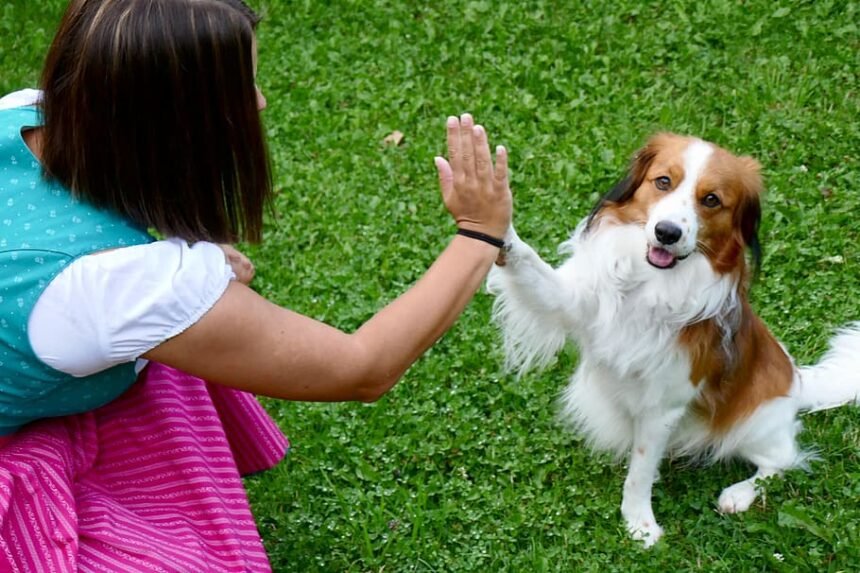Communication is essential in any relationship, and this holds true for the unique bond we share with our canine companions. While verbal commands play a significant role in dog training, incorporating non-verbal cues, specifically hand signals, can significantly enhance the training process and foster a stronger human-dog connection. In this article, we will explore the art of dog training hand signals, the benefits they offer, and how to effectively use them to educate our four-legged friends.
Understanding Dog Body Language
Before delving into the world of hand signals, it’s crucial to comprehend the subtleties of canine body language. Dogs communicate through various physical cues, such as ear positioning, tail wagging, and eye contact. By understanding these cues, you can establish a deeper level of communication with your dog, laying the foundation for successful hand signal training.
Basic Hand Signals for Dog Obedience
- Sit Command: The most fundamental hand signal involves raising your hand, palm facing upward, from your side to shoulder level. Pairing this gesture with the verbal command “sit” and rewarding your dog for complying will reinforce the association and encourage obedience.
- Stay Command: For the “stay” command, extend your arm out with your palm facing your dog, as if signaling them to halt. This motion should be maintained for a brief period, gradually increasing the duration as your dog becomes more proficient.
- Come Command: To teach the “come” command, simply crouch down, open your arms wide, and use an inviting gesture to encourage your dog to come to you. Reward their prompt response to reinforce the behavior.
- Stay Command: In addition to the hand signal mentioned earlier, you can reinforce the “stay” command by extending your palm forward, like a traffic stop signal. This gesture further emphasizes the need for your dog to remain still until given permission to move.
- Lie Down Command: To teach your dog to “lie down,” lower your hand with an open palm towards the ground. This motion helps your dog associate the signal with the desired action of lying down.
- Stand Command: Encourage your dog to “stand” by holding your hand perpendicular to the ground, palm facing outward, and giving a slight upward motion. This hand signal helps when grooming, examining, or simply getting your dog to stand from a sitting or lying position.
Advance Hand Signals For Dog
Once your dog has mastered the basics, you can move on to more advanced hand signals for complex commands.
- Down Command: For the “down” command, use a downward sweeping motion with your hand, palm facing the ground. Be patient and encouraging as your dog learns to lie down upon this signal.
- Heel Command: Teach your dog to walk calmly by your side using the “heel” command hand signal. Hold your hand close to your leg with the palm facing your body, signaling your dog to stay beside you.
- Leave It Command: For impulse control training, teach your dog to “leave it” by extending your arm with your palm facing them, as if creating a physical barrier. Reward their restraint when they resist the temptation.
- Wait Command: The “wait” command is useful for situations when you want your dog to hold their position momentarily. Use an open palm, like a halt sign, to signal your dog to pause and hold their ground until given further direction.
- Drop It Command: To teach your “drop it” command, form a fist with your hand and then open it quickly, mimicking the release of an object. This signal prompts your dog to let go of whatever they have in their mouth.
Some Complex Commands for Dog
- Back Up Command: To teach your dog to “back up,” use both hands with your palms facing your dog. Use a pushing motion to guide them backward, encouraging them to move away from you.
- Speak/Quiet Command: For the “speak” command, raise your hand to your mouth, as if signaling them to bark. For the “quiet” command, lower your hand down in front of your mouth, signaling them to stop barking.
- Go to Your Bed Command: Use a designated hand signal, such as pointing towards their bed, to instruct your dog to “go to your bed.” With consistent reinforcement, they will learn to return to their designated spot when given this signal.
- Roll Over Command: To teach your dog to “roll over,” use a circular motion with your hand, encouraging them to follow the movement and perform the trick.
- Paw/Shake Hands Command: For the “paw” or “shake hands” command, extend your hand and tap your knee or hold it out in front of you. Your dog will learn to offer their paw in response to this signal.
Tailoring Hand Signals to Individual Dogs
Every dog is unique, and understanding their breed-specific traits and learning style is essential for successful hand signal training. Some breeds may respond better to certain hand signals, while others may require more patience and repetition. Tailor your approach to suit your dog’s personality and abilities.
Training Tips and Techniques
Use positive reinforcement in combination with hand signals to encourage your dog’s desired behavior. Reward them with treats, praise, or affection when they respond correctly to the signals. Consistency, patience, and a calm demeanor are key factors in effective training.
Avoiding Common Mistakes in Hand Signal Training
One common mistake is overusing verbal commands alongside hand signals, which can lead to confusion. Instead, focus on using clear and consistent signals without relying excessively on spoken cues.
Incorporating Hand Signals into Daily Life
To reinforce the training, incorporate hand signals into everyday interactions with your dog. Use signals during walks, playtime, and other activities to enhance communication and reinforce their training.
Troubleshooting Challenges in Hand Signal Training
If your dog faces challenges in responding to hand signals, identify potential distractions and work on building their focus. Seeking guidance from a professional trainer can also help address specific issues and refine your training techniques.
Dog training hand signals offer a powerful means of non-verbal communication that can deepen the bond between you and your dog. By understanding dog body language, teaching basic and advanced hand signals, you can create a harmonious and well-trained partnership. Through positive reinforcement and consistent practice, you’ll enjoy a more obedient, responsive, and joyful four-legged friend for life.







